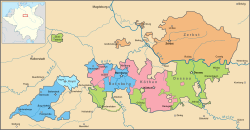Principality of Anhalt-Zerbst
| Principality of Anhalt-Zerbst | ||||||||||||||
| Fürstentum Anhalt-Zerbst (German) | ||||||||||||||
| State of the Holy Roman Empire | ||||||||||||||
|
||||||||||||||
|
Anhalt principalities (1747-1793), Zerbst in orange
|
||||||||||||||
| Capital | Zerbst | |||||||||||||
| Languages | Upper Saxon | |||||||||||||
| Government | Principality | |||||||||||||
| Historical era | Middle Ages | |||||||||||||
| • | Partitioned from Anhalt | 1252 | ||||||||||||
| • | Partitioned into A-Dessau and A-Köthen |
1396 |
||||||||||||
| • | Partitioned from Anhalt-Dessau |
1544 |
||||||||||||
| • | Partitioned1 | 1603 | ||||||||||||
| • | Partitioned2 | 1667 | ||||||||||||
| • | Divided by A-Dessau, A-Köthen and A-Bernburg | 1796 | ||||||||||||
| • | Duchy of Anhalt reunited |
1863 |
||||||||||||
|
||||||||||||||
| 1: In 1603, Anhalt-Zerbst lost territory to Anhalt-Dessau, Anhalt-Bernburg, Anhalt-Plötzkau and Anhalt-Köthen. 2: In 1667, Anhalt-Zerbst lost territory to create Anhalt-Mühlingen and Anhalt-Dornburg. |
||||||||||||||

18th century arms
of Anhalt-Zerbst
Anhalt-Zerbst was a principality of the Holy Roman Empire ruled by the House of Ascania, with its residence at Zerbst in present-day Saxony-Anhalt. It emerged as a subdivision of the Principality of Anhalt from 1252 until 1396, when it was divided into the principalities of Anhalt-Dessau and Anhalt-Köthen. Recreated in 1544, Anhalt-Zerbst finally was partitioned between Anhalt-Dessau, Anhalt-Köthen, and Anhalt-Bernburg in 1796 upon the extinction of the line.
It was created when the Anhalt territory was divided among the sons of Prince Henry I into the principalities of Anhalt-Aschersleben, Anhalt-Bernburg and Anhalt-Zerbst in 1252. In the course of the partition, Prince Siegfried I, the youngest son of Henry I, received the lands around Köthen, Dessau, and Zerbst. His son and successor Prince Albert I took his residence at Köthen Castle in 1295. In 1396, the surviving sons of Prince John II of Anhalt-Zerbst again divided their heritage: Sigismund I became Prince of Anhalt-Dessau and his younger brother Albert IV went on to rule as Prince of Anhalt-Köthen.
...
Wikipedia

